Vision Score Meaning: Understanding Eye Test Results & Visual Acuity
Updated On: October 23, 2025 by Aaron Connolly
Vision Score Meaning Explained
Vision scores basically show how well your eyes pick up details at certain distances compared to what’s considered normal sight. Eye doctors use these numbers to figure out if you might need glasses, contacts, or some other way to sharpen your vision.
Definition of Vision Score
A vision score measures your visual acuity—basically, how sharply you can see things from a standard distance. Most tests use 20 feet as the baseline.
You’ll usually see the score written as a fraction, like 20/20 or 20/40. The first number is always the testing distance, typically 20 feet.
The second number tells you how far away a person with normal vision could see the same thing.
20/20 vision means you can see at 20 feet what an average person sees at 20 feet. People call this normal vision, but honestly, it’s not “perfect” vision.
If you have 20/40 vision, you need to be 20 feet away to see what someone with regular eyesight can spot from 40 feet. The bigger that second number gets, the blurrier your vision is.
Some countries use metres instead of feet. In that case, 6/6 vision is the same as 20/20.
Interpreting Vision Score Results
Knowing your vision score helps you figure out if you might need some kind of correction. Here’s a quick breakdown:
| Vision Score | What It Means |
|---|---|
| 20/15 or better | Above-average vision |
| 20/20 | Normal vision |
| 20/25 to 20/40 | Mild vision impairment |
| 20/50 to 20/80 | Moderate vision problems |
| 20/100 or worse | Severe vision impairment |
If your score is worse than 20/40, you’ll probably need glasses or contacts to see clearly. Many places require at least 20/40 vision for things like driving.
But remember, your visual acuity score only covers one part of vision. It doesn’t say anything about your colour vision, side vision, or depth perception.
Different issues mess with your score in different ways. Nearsightedness makes distant stuff fuzzy, while farsightedness makes nearby things tough to see.
Importance for Eye Health
Getting your visual acuity checked regularly can catch vision problems early—way before they get serious. This is especially true for kids, since early detection can help prevent learning issues.
Your vision score helps your eye doctor pick the right prescription strength for glasses or contacts. That way, you get the sharpest vision possible.
If your visual acuity changes over time, it could mean you’re developing an eye condition. Stuff like glaucoma or macular degeneration might show up in your scores before you even notice any symptoms.
Most adults should get their eyes checked every couple of years. If you’re over 60 or have diabetes, yearly checks are a good idea.
Good visual acuity makes daily stuff like reading, driving, and working a whole lot easier. If you ignore poor scores, you might end up with a lower quality of life—or even put your safety at risk.
Even if you’ve got 20/20 vision, you shouldn’t skip eye exams. Some serious diseases don’t mess with your visual acuity until they’re pretty far along.
How Vision Scores Are Calculated
Vision scores use a simple fraction system that compares your eyesight to what doctors call normal vision. The numbers show how well you can read letters on an eye chart at a certain distance.
Understanding the Vision Score Fraction
You’ll see vision scores as fractions—20/20, 20/40, and so on. This just compares your sharpness of vision to what’s considered normal.
If you’ve got 20/20 vision, your eyesight matches what doctors expect from healthy eyes.
Here’s the basic breakdown:
- 20/20 = Normal visual acuity
- 20/40 = Below normal vision
- 20/60 = Poor visual acuity
- 20/200 = Legally blind
Think of it like a ratio. The lower the bottom number, the better your vision. If the bottom number gets bigger, your vision isn’t as sharp.
Some countries use 6/6 instead of 20/20, but the idea’s the same.
What the Top and Bottom Numbers Indicate
The top number is the test distance in feet. The bottom number shows how far away someone with normal vision could read the same line.
Top number (first number):
- Always 20 in US and UK tests
- Means you’re 20 feet from the chart
- This distance doesn’t change
Bottom number (second number):
- Tells you about your vision quality
- Higher numbers = worse vision
- Lower numbers = better vision
So, if you score 20/40, you can see at 20 feet what a person with normal vision sees at 40 feet. You need things to be closer to see them clearly.
A 20/15 score? That means you can see at 20 feet what most people need to be 15 feet away to see. Not bad at all.
Normal versus Abnormal Scores
20/20 vision is the gold standard, but plenty of people have scores a little off from that. If your score is abnormal, you might need glasses or another checkup.
Normal vision ranges:
- 20/15 to 20/20 = Excellent to normal
- 20/25 = Slightly below normal but usually fine
Abnormal vision scores:
- 20/40 = Often the cutoff for driving without glasses
- 20/60 = Significant impairment
- 20/200 or worse = Legally blind
Most people can get by with 20/40 vision for everyday stuff. But for driving or detail work, you’ll probably need correction.
Distance vision tests check how well you see far away. Near vision tests use charts you hold up close.
Visual Acuity: Core Concept
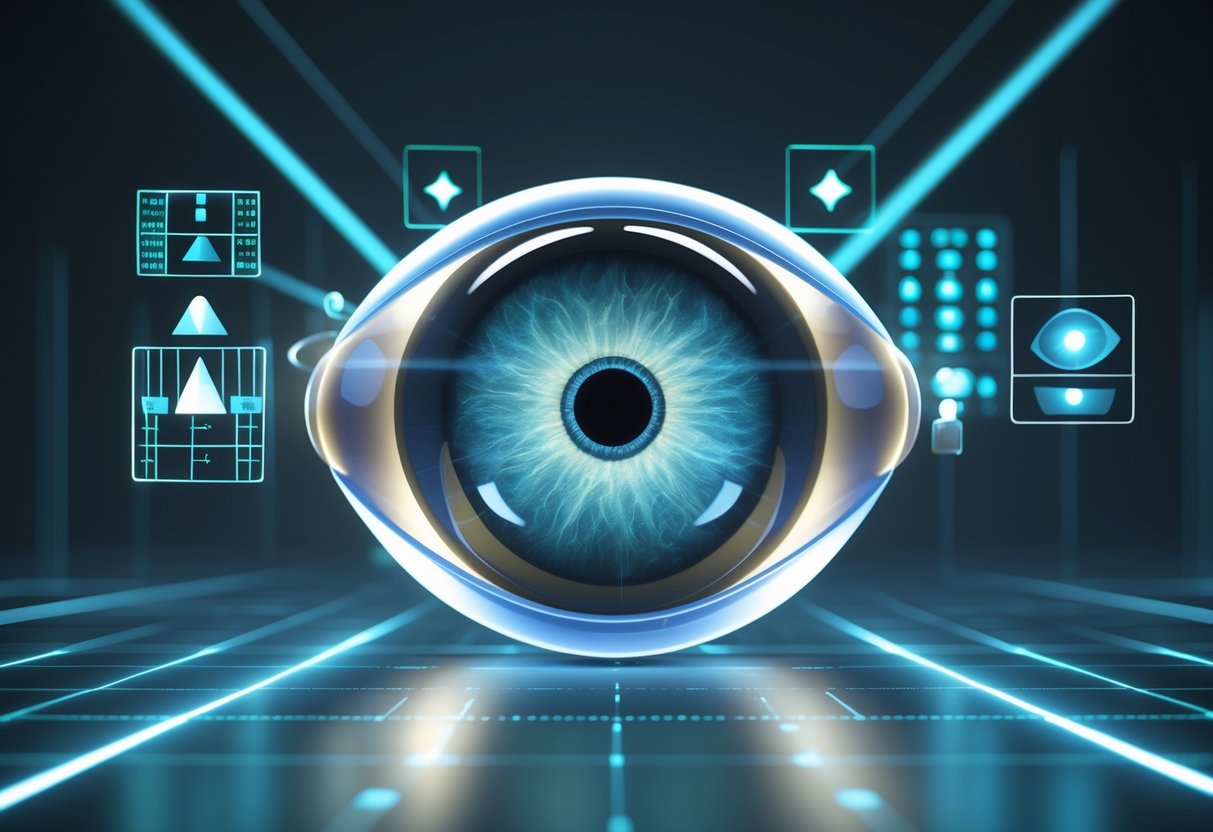
Visual acuity is just a fancy term for how clearly you see details at a set distance, usually written as a fraction like 20/20. This measurement sits at the heart of every eye exam and affects all sorts of daily stuff—reading, driving, you name it.
Definition of Visual Acuity
Visual acuity is the sharpness of your vision. It checks how well you can see tiny details from a standard distance, with no glasses or contacts.
Here’s how it usually goes:
- You stand 20 feet from an eye chart
- Cover one eye
- Read the smallest line you can see
You’ll get a fraction as your result. The first number is always your test distance (20 feet). The second number is the distance where someone with normal vision could read that same line.
Some common scores:
- 20/20: Normal vision
- 20/40: You see at 20 feet what normal vision sees at 40 feet
- 20/15: Better than normal
- 20/200: Legal blindness threshold
Doctors can measure your visual acuity with or without correction. For stuff like driving licenses, your corrected score is what matters.
Role in Eye Examinations
Visual acuity testing is the backbone of any eye exam. Eye care pros use it to check your eye health and see if you need glasses or contacts.
During an exam, they usually test your distance vision first with a standard chart. The Snellen chart—the one with the big E at the top—is the classic choice.
The process goes like this:
- Cover one eye, then the other
- Read the lines from largest to smallest
- They record the smallest line you get right
- If you wear glasses, they’ll test you with and without them
Your score helps pinpoint issues like myopia (nearsightedness), hyperopia (farsightedness), and astigmatism. These conditions mess with how light focuses in your eye, making things blurry at certain distances.
Some people, like athletes or pilots, need special tests for dynamic visual acuity—seeing clearly while things are moving.
Visual Clarity and Daily Life
How well you see details affects almost everything you do. If your vision isn’t sharp, life can get tricky fast.
You need good distance vision for stuff like:
- Driving and reading signs
- Watching TV or movies
- Recognising faces from across the room
- Playing sports that involve tracking things
If your vision gets worse, it’s not just about seeing clearly. It can really hit your confidence, make you less mobile, and even hurt your job performance. Sometimes, people don’t even realise their vision slipped until they get an eye test.
You might notice:
- Squinting to see far away
- Trouble reading street signs while driving
- Headaches after doing things that require focus
- Eye strain from staring at screens
Regular eye exams catch changes in your vision early. Most refractive errors are easy to fix with glasses, contacts, or surgery. Spotting problems like glaucoma or cataracts sooner makes a big difference in treatment.
Your visual acuity score also decides if you’re okay to drive, work certain jobs, or join the military.
Types of Vision Measured
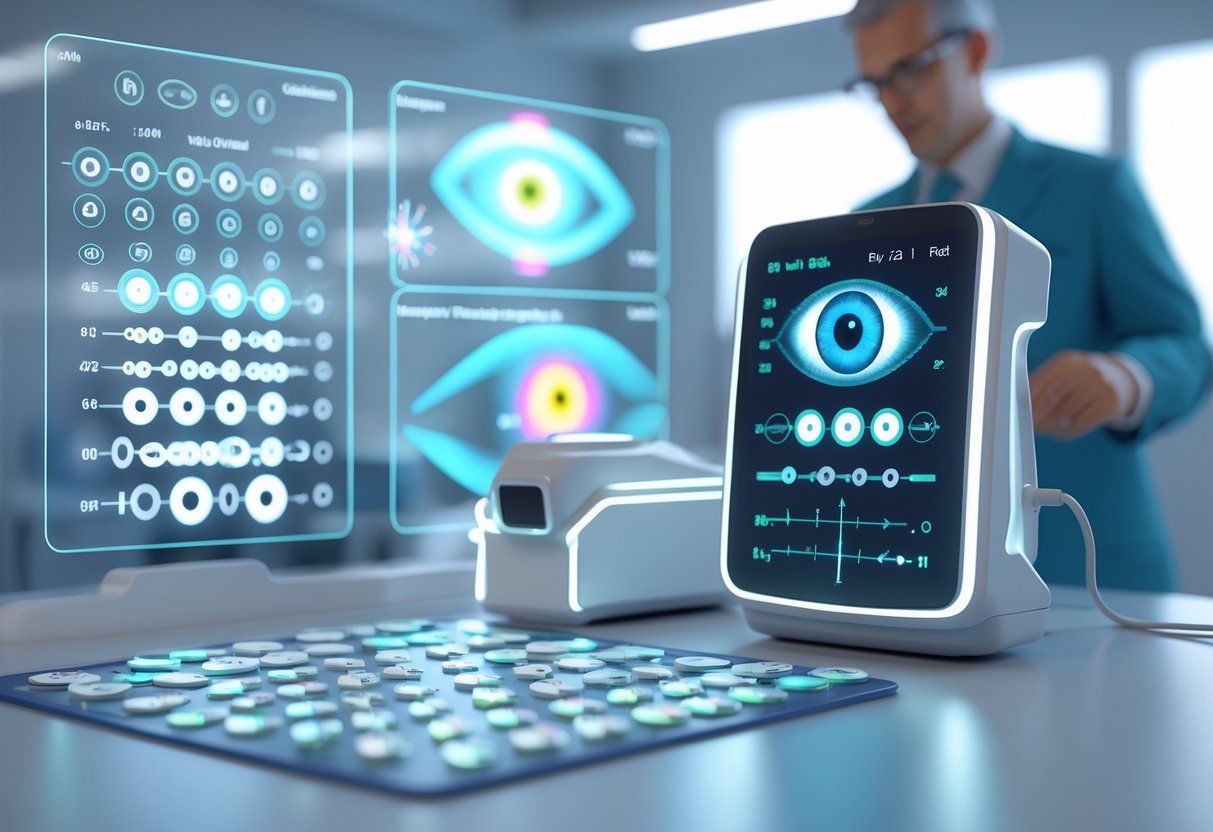
Eye doctors look at a few different types of vision to get the full picture of how your eyes work. Each type checks a specific skill, from reading signs to catching something out of the corner of your eye.
Distance Vision
Distance vision is about how clearly you see things that are far away. This is what most people think of when they hear about vision tests.
Doctors use charts with letters or symbols 20 feet away. The Snellen chart—the one with rows of letters—is the classic tool for this.
You’ll get a score like 20/20 or 20/40. The first number is always 20, meaning you stood 20 feet from the chart. The second number shows what size letters you could read.
Normal distance vision is 20/20. You can see at 20 feet what most people see at 20 feet.
With 20/40 vision, you need to be closer—20 feet away to see what others see from 40 feet. Not ideal.
If your distance vision is off, you might struggle with road signs, movies, or recognising faces from across a room.
Near Vision
Near vision checks how well you see things up close, usually at 14 to 16 inches. This gets more important as you get older.
Doctors hand you a card with tiny text in different sizes. You hold it at reading distance and try to read the smallest print you can.
Near vision problems are called presbyopia. As you age, the lens in your eye stiffens up and just doesn’t focus as well.
Most people start noticing near vision issues in their 40s. Reading books, checking your phone, or doing close work gets harder.
Reading glasses, bifocals, or contacts usually solve the problem. A lot of people end up needing different prescriptions for far and near vision.
Peripheral Vision
Peripheral vision is your ability to notice things off to the sides while you’re looking straight ahead. People also call it side vision.
Peripheral vision lets you spot cars coming from the side, see people walking by, and avoid bumping into stuff. It’s super important for safety.
Doctors test peripheral vision with special machines or by moving objects into your side view. You focus on a central point and signal when you see something appear at the edge.
Normal peripheral vision stretches about 90 degrees each way. If you lose some of it, it could mean you’ve got glaucoma or a retinal problem.
Losing side vision makes driving risky and raises your chances of tripping or running into things.
Contrast Sensitivity
Contrast sensitivity checks how well you can spot differences between objects and their background, especially in dim light or fog.
This isn’t the same as the regular vision test. You could have 20/20 vision and still struggle in low light or with faint text.
Doctors use charts with letters or patterns that fade from black to light grey. You try to pick out the faintest thing you can see.
Good contrast sensitivity helps you drive at night and see steps or curbs in bad lighting. It makes reading easier when the light isn’t great.
Contrast sensitivity can drop with cataracts, diabetes, or just getting older. You might not notice it on a standard eye test, but it still affects your daily life.
Vision Testing Methods & Charts
Eye doctors use several types of charts to check how well you see details at certain distances.
The Snellen chart is still the most common, but LogMAR charts offer more precise measurements. Some charts are designed for people with different needs.
Snellen Chart
The Snellen chart is the classic one you’ll spot in most eye doctors’ offices.
Dutch eye doctor Herman Snellen came up with it back in 1862, and honestly, it’s still everywhere.
You’ll see rows of letters that shrink as you move down the chart. The top row? Just one big letter, usually an “E.”
Each row below has more letters, and they keep getting smaller.
When you take a Snellen test, you sit 20 feet from the chart. You cover one eye and start reading from the top.
The doctor writes down the smallest line you can read clearly.
Snellen chart highlights:
- Letters shrink by set ratios
- Standard distance: 20 feet
- Results as fractions (like 20/20 or 20/40)
- Random letters to keep things fair
The Snellen chart works well for most adults who can read. But it’s not so great for young kids or folks who don’t know the alphabet.
LogMAR Chart
The LogMAR chart gives more accurate vision results than the old Snellen charts.
LogMAR stands for “Logarithm of the Minimum Angle of Resolution.” Bit of a mouthful, right?
Charts like Bailey-Lovie and ETDRS use the LogMAR system. They have five letters per line, and each line gets a bit harder, but always by the same amount.
LogMAR charts nail the details because they’re designed mathematically. Every letter has the same space around it, and the size changes predictably between lines.
Why LogMAR is useful:
- Consistent letter spacing
- Always five letters per line
- More accurate results
- Used in research a lot
Eye doctors like LogMAR charts for detailed checks. They help track tiny changes in your vision over time.
These charts are especially handy for keeping an eye on diseases or seeing if a treatment’s working.
Jaeger Chart
The Jaeger chart checks your near vision, not distance like the others.
You hold this chart about 14–16 inches from your eyes and try to read different paragraphs in varying sizes.
The text blocks are numbered from J1 (smallest) to J11 (largest). Most people with normal near vision read J1 or J2.
This test often finds presbyopia, that annoying thing where close-up stuff gets blurry as you get older.
It’s also great for people who do lots of close work, like reading or staring at screens all day.
Jaeger chart features:
- Tests reading vision up close
- Uses real text, not just letters
- Numbered sizes (J1–J11)
- Handheld and easy to use
Eye exams usually include both distance and near vision tests. The Jaeger chart fills in the gaps that distance charts miss.
Tumbling E Chart
The Tumbling E chart only uses the letter “E,” but it points in different directions.
This chart helps people who can’t read regular letters—kids, non-English speakers, you name it.
Instead of reading out letters, you just point to show which way the “E” faces: up, down, left, or right.
The E’s get smaller as you go down, just like other charts.
It works like the Snellen chart but skips the language barrier. The E’s match the size of regular chart letters, so results line up.
Why Tumbling E works:
- No reading needed
- Good for young children
- Doesn’t matter what language you speak
- Just as accurate as letter charts
Doctors use this chart a lot for school screenings or when someone has trouble communicating. It gets the job done without needing to know the alphabet.
Understanding 20/20, 20/40, and Other Scores
Vision scores use a simple fraction. They show how sharp your eyesight is compared to what’s considered normal.
These numbers help doctors figure out if you need glasses and keep tabs on your vision over time.
Meaning of 20/20 Vision
20/20 vision is what we call normal vision. The first number is how far you stand from the chart—20 feet.
The second number tells you the distance at which a person with normal vision can read the same line.
If you have 20/20 vision, you see at 20 feet what someone with normal eyesight sees at 20 feet. Basically, your eyes focus light onto your retina the way they should.
A lot of folks think 20/20 means perfect vision. It really doesn’t.
Normal visual acuity doesn’t check things like:
- Peripheral vision
- Colour vision
- Depth perception
- Night vision
About 35% of adults naturally have 20/20 vision with no glasses or contacts. Most people can hit 20/20 with corrective lenses if they need them.
20/40 and 20/60 Explained
20/40 vision means you need to be 20 feet away to see what someone with normal vision can see from 40 feet.
That’s mild visual impairment and usually means you’ll want glasses for sharper vision.
With 20/40, you can usually:
- Read books without much trouble
- Use a computer just fine
- Drive during the day in most places
20/60 vision is a bigger problem. You have to be much closer—20 feet—to see what others see at 60 feet.
| Vision Score | Driving Licence Status | Correction Needed |
|---|---|---|
| 20/40 | Usually allowed | Often recommended |
| 20/60 | May require restrictions | Definitely needed |
| 20/80 | Often restricted | Essential |
Most countries want at least 20/40 vision for a full driver’s licence.
What Is Considered Legally Blind?
Legally blind means your visual acuity is 20/200 or worse in your better eye, even with glasses or contacts.
That’s not the same as total blindness.
If you have 20/200 vision, you can only see at 20 feet what a person with normal vision can see at 200 feet.
You might still be able to see:
- Large shapes and movement
- Bright lights and colours
- Some very large text
Legal blindness also means having a visual field of 20 degrees or less. Most people have about 170 degrees of peripheral vision.
People who are legally blind often qualify for:
- Disability benefits
- Special education services
- Assistive tech programmes
- Guide dog training
Only about 15% of legally blind people see nothing at all.
Significance of Better or Worse Than 20/20
You can have better than 20/20 vision. Some people naturally see at 20/15 or even 20/10, spotting details most of us miss.
Athletes often have sharper vision:
- Tennis players with 20/15 vision track the ball better
- Pilots need great distance vision
- Surgeons rely on crisp near vision
If your vision is worse than 20/20, you don’t always need glasses right away.
A few things matter:
- Age: Vision usually dips after 40
- Activities: Computer work and driving need different corrections
- Comfort: Eye strain can matter more than your score
Vision changes for a bunch of reasons:
- Health issues like diabetes
- Medications
- Eye injuries
- Just getting older
Regular eye exams help you spot changes early and keep your vision as sharp as possible.
Who Conducts Vision Scoring and Assessments

Eye doctors and trained professionals run vision scoring tests to see how well you can see.
Ophthalmologists handle complex eye diseases, while optometrists focus on everyday eye care and vision correction.
Role of Ophthalmologists
Ophthalmologists are medical doctors who specialise in all things eye and vision.
They attend medical school and then train for years in surgery and disease treatment.
These doctors include vision scoring in their full eye exams. They diagnose and treat serious problems like glaucoma, cataracts, and diabetic retinopathy.
Ophthalmologists handle:
- Detailed Snellen chart testing
- Measuring vision before and after treatments
- Tracking vision changes from diseases
- Performing surgery to improve vision
Ophthalmologists usually see patients with trickier vision problems. They rely on vision scoring to see how treatments are working.
If a regular eye exam finds something serious, you’ll likely end up seeing an ophthalmologist. They’re trained for conditions that could cause permanent vision loss.
Role of Optometrists
Optometrists are your go-to for primary eye care. They spend four years in optometry school after college.
Most vision scoring happens during optometrist visits. They use eye charts to measure how well you see and figure out if you need glasses or contacts.
Optometrists offer:
- Annual eye exams with vision scoring
- Prescriptions for corrective lenses
- Early detection of common eye problems
- Management of some eye conditions
Optometrists do most vision checks in the UK. They can spot early signs of disease during your regular eye test.
They’re usually your first stop for eye care. If they find a serious problem, they’ll refer you to an ophthalmologist.
Other Eye Care Professionals
Other trained professionals help with vision scoring and eye assessments. They support ophthalmologists and optometrists to give you full care.
Ophthalmic technicians run vision tests under a doctor’s supervision. They know how to use charts and basic testing equipment for checking how well you see.
Orthoptists focus on eye movement and how both eyes work together. They do special vision tests for people with binocular vision problems.
Dispensing opticians fit and provide glasses and contacts. They don’t do vision scoring, but they make sure your prescription gets filled correctly.
Some optical shops have staff who do basic vision screening. But for a full vision score, you should see a qualified optometrist or ophthalmologist.
Correcting Vision Impairments
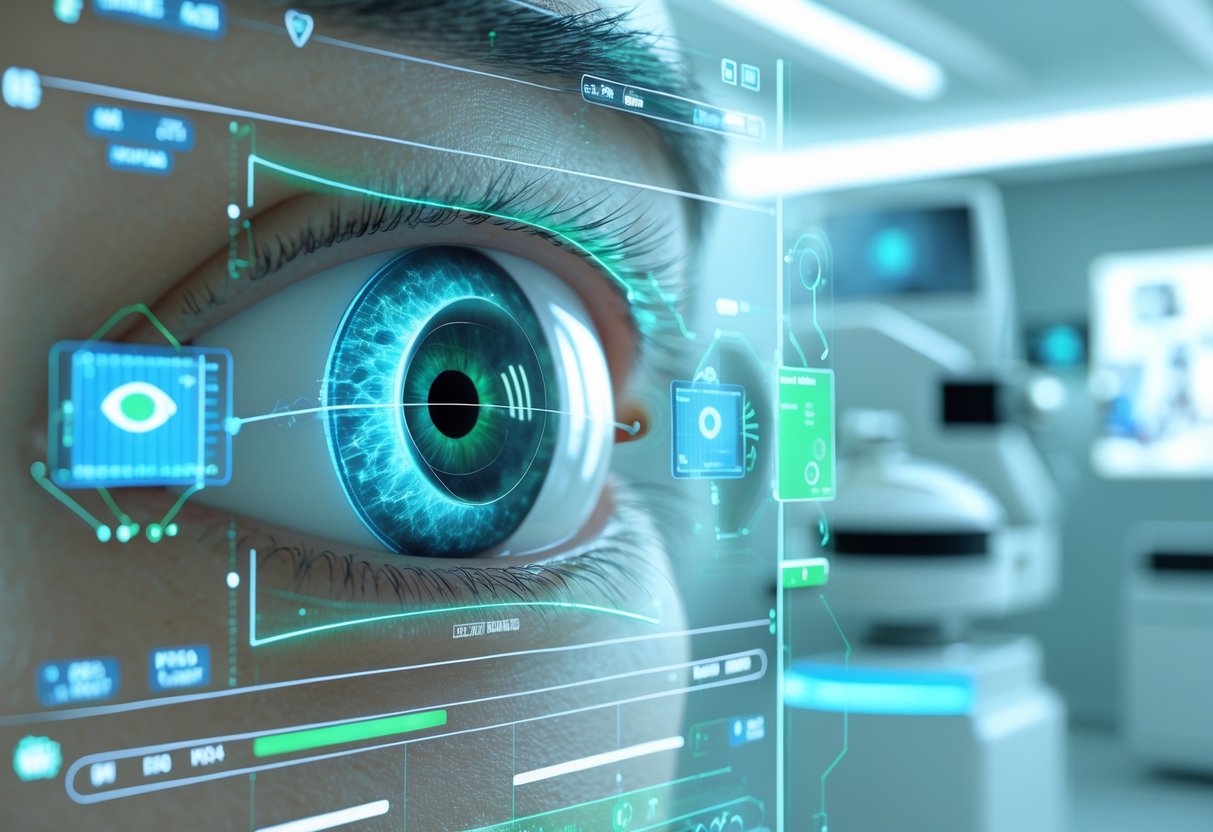
Most vision problems get better with glasses, contacts, or other aids.
Regular eye exams help you catch issues early and find the right fix for your vision score.
Use of Glasses and Corrective Lenses
Glasses are the go-to fix for vision problems. They change how light enters your eyes to make things look sharp again.
An eye exam shows exactly what lens strength you need. The doctor writes your prescription based on your test results.
Contact lenses do the same thing as glasses, but they sit right on your eye. Lots of people like them for sports or just for looks.
Corrective lenses can fix:
- Myopia (short-sightedness): Faraway things look fuzzy
- Hyperopia (long-sightedness): Close-up things are blurry
- Astigmatism: Everything looks a bit blurry
- Presbyopia: Reading gets tough as you age
Modern lenses are lighter and thinner than ever. You can pick from loads of frame styles and lens types.
Other Visual Aids
Some folks need more than regular glasses.
Magnifying glasses make text and objects bigger.
Reading glasses with built-in lights help in dim rooms. Large-print books and high-contrast materials also make reading easier.
Digital tools include:
- Screen readers
- Voice-activated gadgets
- Magnifier apps on your phone
- Text-to-speech programs
For severe vision loss, white canes and guide dogs offer mobility support. These help people get around safely.
Telescopic glasses help you see faraway things better. They’re handy for TV or reading street signs.
Improving Your Vision Score
Regular eye exams keep your vision in check. Most adults should get tested every two years.
Your eyes can change as you age. Updating your prescription keeps your glasses or contacts working right.
A few habits help protect your eyes:
- Take breaks from screens every 20 minutes
- Wear sunglasses in bright sunlight
- Eat foods high in vitamins A and C
- Avoid smoking
Surgery like LASIK can permanently boost your vision score. These operations reshape your eye so you need glasses less—or not at all.
But surgery isn’t for everyone. Your eye doctor will let you know if it’s a good fit for you based on your eyes and vision score.
Common Vision Problems Identified by Scores
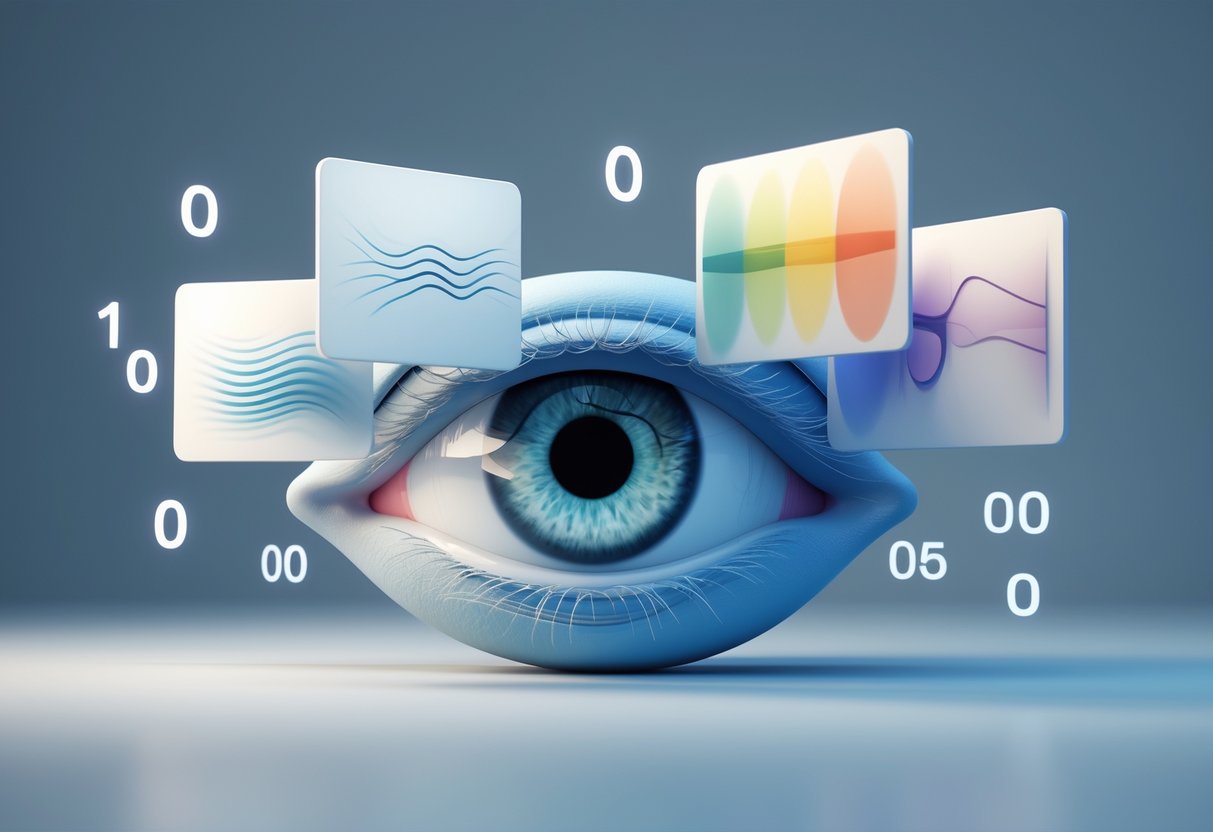
Vision scores give us a window into specific eye conditions that mess with how clearly we see the world. These numbers help eye care pros spot issues like astigmatism, colour blindness, and low vision—all things that can really affect daily life.
Astigmatism Detection
Astigmatism pops up in vision scores when our eyes can’t focus light evenly. Basically, the cornea isn’t perfectly round—it looks more like a rugby ball than a football.
Common astigmatism scores:
- 20/30 to 20/50 (mild)
- 20/60 to 20/100 (moderate)
- 20/200 or worse (severe)
If you have astigmatism, you probably notice blurry vision no matter the distance. Letters on eye charts might look stretched or kind of weird during the test.
Eye doctors test for astigmatism with charts full of lines at different angles. If you find horizontal lines easier to read than vertical ones, that’s a sign.
Heads up: Ignoring astigmatism can lead to headaches and eye strain from all the squinting.
Most people with astigmatism end up with glasses or contacts to fix the focus. If your case is severe, you might need special toric lenses with different powers in different spots.
Colour Blindness Assessment
Standard vision scores don’t actually catch colour blindness, which affects about 8% of men and 0.5% of women. You need special colour vision tests, not just the usual eye charts.
The Ishihara test uses coloured dots with hidden numbers or shapes. People with colour blindness miss certain patterns that others spot right away.
Most common types:
- Red-green colour blindness (by far the most common)
- Blue-yellow colour blindness (pretty rare)
- Complete colour blindness (almost unheard of)
Colour blindness doesn’t mess with your sharpness score, like 20/20 vision. You could have perfect distance vision and still have trouble with colours.
Quick tip: Loads of online colour blindness tests are out there, but a real diagnosis requires a pro and standardised charts.
Colour blindness can make everyday stuff tricky—like reading traffic lights, picking ripe fruit, or matching clothes. Some jobs, especially in aviation or electrical work, require normal colour vision.
Identifying Low Vision and Impairment
Low vision means your best-corrected vision falls between 20/70 and 20/200. If your better eye sees 20/200 or worse, that’s considered legal blindness.
Vision impairment levels:
- Mild: 20/30 to 20/60
- Moderate: 20/70 to 20/160
- Severe: 20/200 to 20/400
- Profound: 20/500 or worse
These scores help figure out what kind of support you might need. Someone at 20/70 might get by with stronger glasses, but at 20/200, special aids usually become necessary.
Low vision makes it tough to:
- Read standard-sized text
- Recognise faces from far away
- Drive safely (usually need 20/40 or better)
- Navigate stairs and obstacles
Vision rehab services help people adjust to low vision. This might mean magnifiers, large-print books, or orientation training.
Plenty of people with low vision still live independently with the right support and tools.
Comparing International Vision Scoring Systems
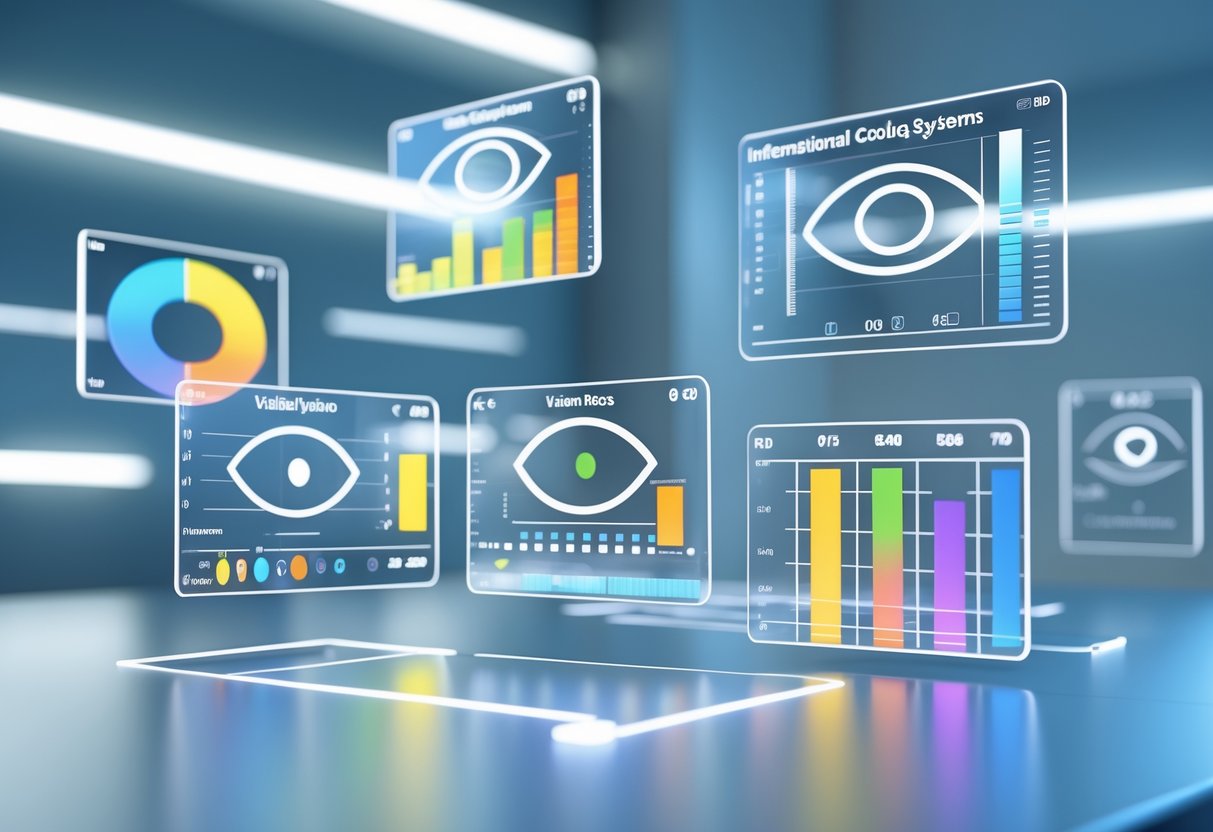
Each country seems to have its own way of measuring vision, but they all come from the same 19th-century idea. The US uses feet, the UK uses metres, and other places tweak things to fit their language or culture.
US Vision Score System
In the US, we use the Snellen chart with feet as the measurement. Normal vision is 20/20, meaning you see at 20 feet what a person with ideal vision sees at 20 feet.
The first number always stays at 20 (the testing distance). The second number tells you how your sight stacks up to normal.
Here’s a quick breakdown:
| Vision Score | What It Means |
|---|---|
| 20/20 | Normal, sharp vision |
| 20/40 | You see at 20 feet what others see at 40 feet |
| 20/60 | You see at 20 feet what others see at 60 feet |
| 20/15 | Better than average—you see at 20 feet what others see at 15 feet |
As that bottom number goes up, your vision gets worse. If you have 20/100 vision, it’s much worse than 20/40.
UK Scoring System: 6/6 Notation
British opticians use metres, not feet. The 6/6 notation works just like the US system but in metric.
6/6 means you can read at six metres what a person with good vision reads at six metres.
Some common scores:
- 6/6 – Normal vision
- 6/12 – You need to be at 6 metres to see what others see at 12 metres
- 6/18 – Moderate trouble seeing
- 6/24 – Significant impairment
The test itself doesn’t really change. You cover one eye, stand the right distance away, and read the smallest letters you can.
Other Global Testing Approaches
South Korea uses a decimal system from 0.1 up to 2.0. The Jin Yong-han chart swaps out English letters for Korean ones, numbers, or even pictures.
Testing starts with big letters at 0.1 and goes down to tiny ones at 2.0. A score of 1.0 means average vision, kind of like 20/20 or 6/6 elsewhere.
The process is a bit different:
- You move closer to the chart until you can see the 0.1 row
- The doctor points at letters in each row, moving downward
- Testing stops when you can’t name the letters anymore
Lots of countries adapt the Snellen chart to their own language. They might use different letters, symbols, or shapes—especially for kids.
What to Expect During an Eye Test
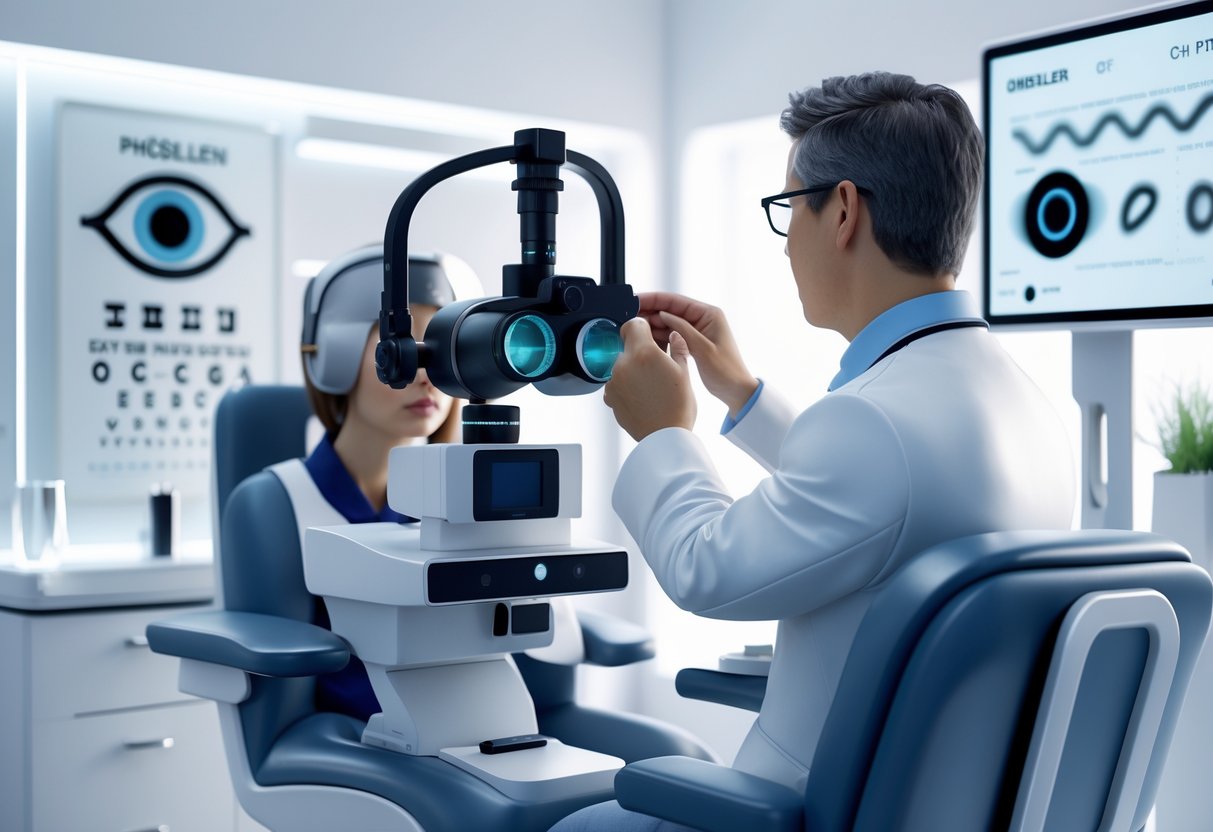
A standard eye test usually takes about 20-30 minutes. You’ll start with the basics and then move into more detailed checks to pin down your prescription.
Step-by-Step of a Standard Eye Examination
Every exam kicks off with a visual acuity test using the Snellen chart. You’ll sit about 20 feet away, cover one eye, and read letters from big to small.
The optometrist will ask you to keep going until the letters get too fuzzy. That gives your baseline score, like 20/20 or 20/40.
If needed, you’ll do the Random E test—just the letter E, rotated different ways. You say which direction each E points.
After that, you might get:
- Depth perception checks with 3D images
- Peripheral vision tests
- Eye pressure readings
- Retina exams with bright lights
The optometrist will probably use a phoropter—the big machine with all the lenses. You’ll look through and answer “better or worse” as they switch lenses to fine-tune your prescription.
Preparing for a Vision Assessment
Try to book your eye test when you’re well-rested and alert. Tired eyes can throw off your results.
Bring your current glasses or contacts with you. The optometrist needs to check what you’re using and how well it’s working.
What to bring:
- Your current glasses or contacts
- A list of any meds you’re taking
- Details about eye issues or family history
- NHS number or insurance info
If you can, take your contacts out a few hours before your test. Contacts can temporarily change your eye shape and mess with the measurements.
Plan for about 30-45 minutes at the clinic. Some tests might dilate your pupils, which can blur your vision for a few hours.
Maintaining and Protecting Eye Health
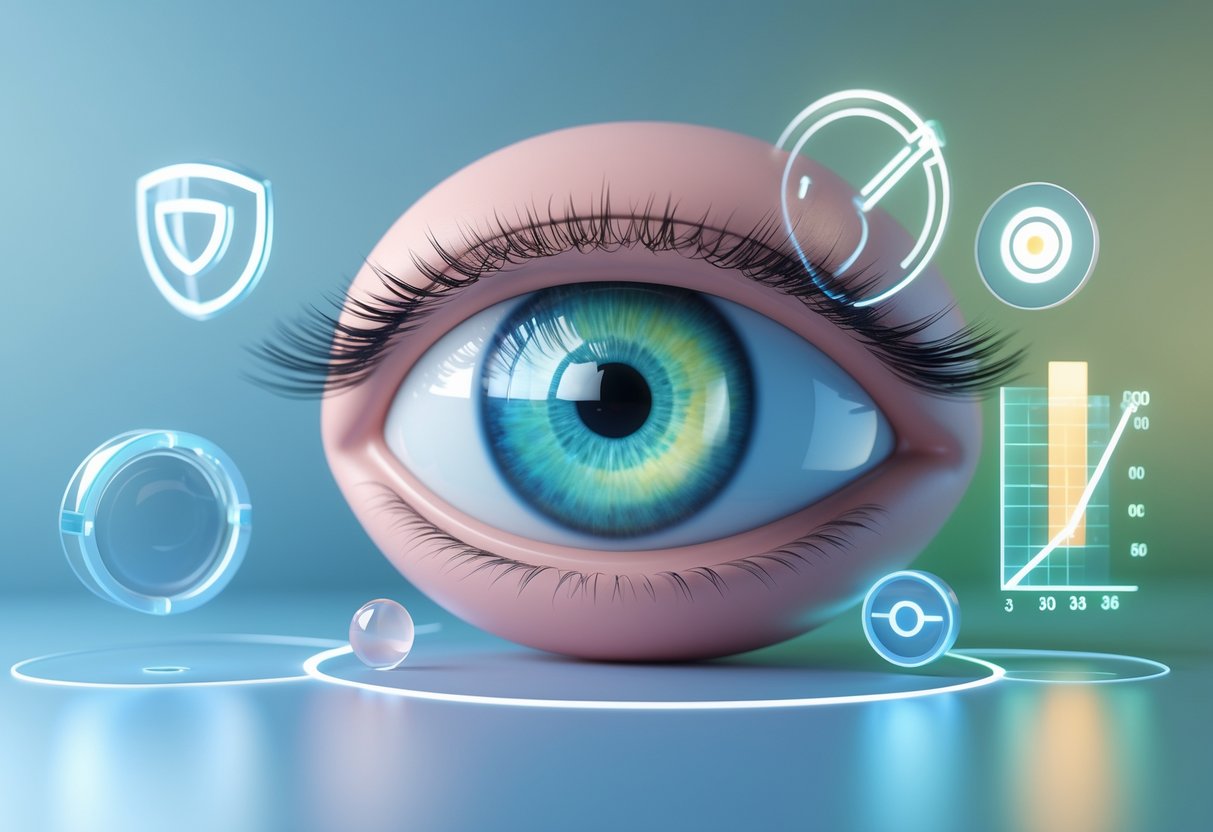
Eye care isn’t just about knowing your scores. Regular check-ups and some easy daily habits can help keep your vision sharp and catch problems early.
Regular Eye Exams
We recommend booking a comprehensive eye exam every 1-2 years, even if you think your vision is fine. Plenty of eye conditions sneak up without obvious symptoms.
How often should you go?
- Ages 18-39: Every 2-3 years
- Ages 40-64: Every 1-2 years
- Ages 65+: Every year
At your visit, the eye care pro will test your vision with charts and check for things like glaucoma, cataracts, and diabetes-related problems.
During your exam, you’ll likely get:
- Visual acuity tests
- Eye pressure measurements
- Pupil dilation for a retina check
- A chat about your family eye health
Don’t wait for vision changes—early detection really does make treatment easier and protects your sight longer.
Lifestyle Tips for Healthy Vision
Daily habits play a big role in eye health, too. These little things add up.
Protect your eyes from UV rays:
- Wear sunglasses with 100% UV protection outside
- Go for wraparound styles if you can
- Don’t skip sunglasses just because it’s cloudy
Eat eye-friendly foods:
- Dark leafy greens like spinach and kale
- Fish full of omega-3s
- Lots of colourful fruits and veggies
Try the 20-20-20 rule when staring at screens: every 20 minutes, look at something 20 feet away for 20 seconds. Your eyes will thank you.
Other good habits:
- Wear safety glasses for sports or DIY
- Wash your hands before touching your eyes
- Get enough sleep so your eyes can rest
Frequently Asked Questions
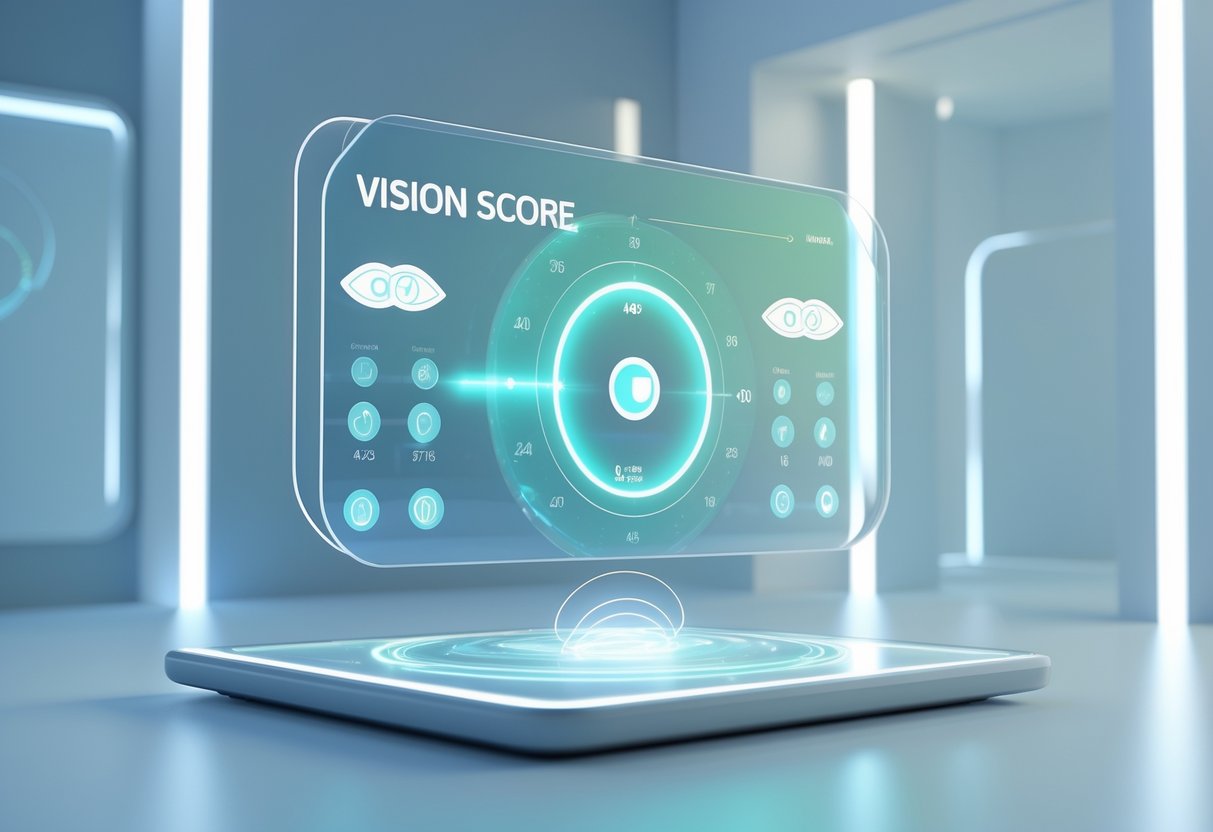
These questions cover both gaming vision scores in League of Legends and the kinds of vision measurements doctors use.
What does a good vision score indicate in a game of League of Legends?
A good vision score in League of Legends basically shows how well you use wards and clear enemy vision. Usually, 1.5 to 2 points per minute is considered solid.
Support players rack up the highest vision scores, often hitting 60-100 points in a 30-minute game. Mid laners and junglers should aim for 40-60 points in the same time.
You boost your vision score by placing wards, clearing enemy wards, or using trinkets smartly. Each action gives different points, depending on how long your wards stay up and how much info they provide.
How can I interpret my eye test results in terms of vision quality?
Eye test results use fractions like 20/20 or 20/40 to measure sharpness. The first number is your testing distance, and the second is the distance at which a person with normal vision can see the same thing.
20/20 means your sight is normal—not perfect, just standard. You see at 20 feet what most people see at 20 feet.
20/40 means you have to stand at 20 feet to see what others see at 40 feet. The higher that second number, the worse your vision quality.
Is there a chart available that explains different vision scores?
There are five main types of eye charts: the Snellen chart, LogMAR chart, Jaeger chart, E chart, and Landolt C chart.
The Snellen chart is the most common—it has rows of letters that get smaller as you go down.
Vision scores can show up as fractions, decimals, or even percentages. For example, 6/18 vision is about 33% if you convert it to a percentage.
What constitutes normal vision measurements for each eye?
Most people call 20/20 vision normal when you check each eye separately. That just means your eyes see with average sharpness, assuming you’re not using glasses or contacts.
Some folks actually see better than that—like 20/15 vision. If you have 20/15, you can spot details at 20 feet that most people only catch at 15.
Doctors always test one eye at a time since your left and right eyes might not see the same. They keep separate scores to catch any differences.
How can one describe perfect vision in medical terms?
Doctors don’t really use the phrase “perfect vision.” Instead, they’ll say someone has 20/15 or even 20/10 vision if their eyesight is sharper than average.
People often think 20/20 means perfect eyesight, but that’s not quite right. It’s just the standard for healthy eyes—not some gold medal.
A visual acuity test checks how clearly you spot things from 20 feet away, and you do it without glasses or contacts.
What are the steps to convert my eye prescription into a 20/20 vision scale?
Eye prescriptions and vision scores? Yeah, they’re not the same thing. Prescriptions use diopters to measure refractive errors, while vision scores tell you how sharp your eyesight is.
If you’re curious, just ask your optometrist. They’ll help connect the dots between your prescription strength and your uncorrected vision score.
Usually, a higher prescription means your natural vision isn’t so great without glasses or contacts.
Once you put on your prescribed glasses or contacts, you can take a corrected visual acuity test. That should bump your vision closer to 20/20.
This corrected score really comes into play for stuff like driving licence applications.

